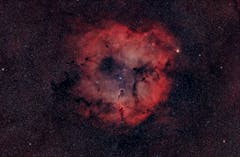ZWO upgraded their Off Axis Guider (OAG) in early 2018. The Off Axis Guider Adapter MKII reflects these improvements with updated design, refined machining, and improved usability for modern imaging trains.
Key Features
- Lightweight, precision-machined construction
- Ultra-compact 16.5mm body thickness
- Large 8 × 8 mm guiding mirror for improved light capture
- Allows simultaneous use of imaging and guide cameras without a separate guide scope
- Compatible with T2 (M42 × 0.75) and M48 threaded systems
- Fully compatible with ZWO ASI cameras
Note: Cameras with large sensors such as ASI174 may experience vignetting. Smaller sensor guide cameras are recommended. - Rigid, stable connection to the telescope
What’s in the Box
- OAG body (includes 1.25″ holder, 5mm extender, and M42 adapter)
- M48 adapter for main imaging camera
- M48–M42 adapter for telescope or field flattener
- Hex key (Allen wrench)
Mechanical Diagram
Connection Diagram
How to Use the ZWO Off Axis Guider Adapter MKII
- Calculate the required back focus for your imaging train.
Example: To reach 55mm with an ASI071 camera: 17.5mm + 21mm extender + 16.5mm OAG = 55mm - Remove the prism assembly and attach the OAG body to the telescope.
- Reinsert the prism assembly into the OAG body.
- Mount the guide camera.
- Attach the appropriate T2 or M48 adapter to the imaging camera.
- Mount the imaging camera to the OAG and secure it using the three thumb screws.
- Installation is complete.
Important Notes
Ensure that the prism does not intrude into the imaging sensor’s field of view.
Use the guiding adjustment screw to fine-tune guide camera focus. It is strongly recommended to perform this adjustment during daylight to ensure both the imaging and guide cameras reach focus at the same optical position.





















